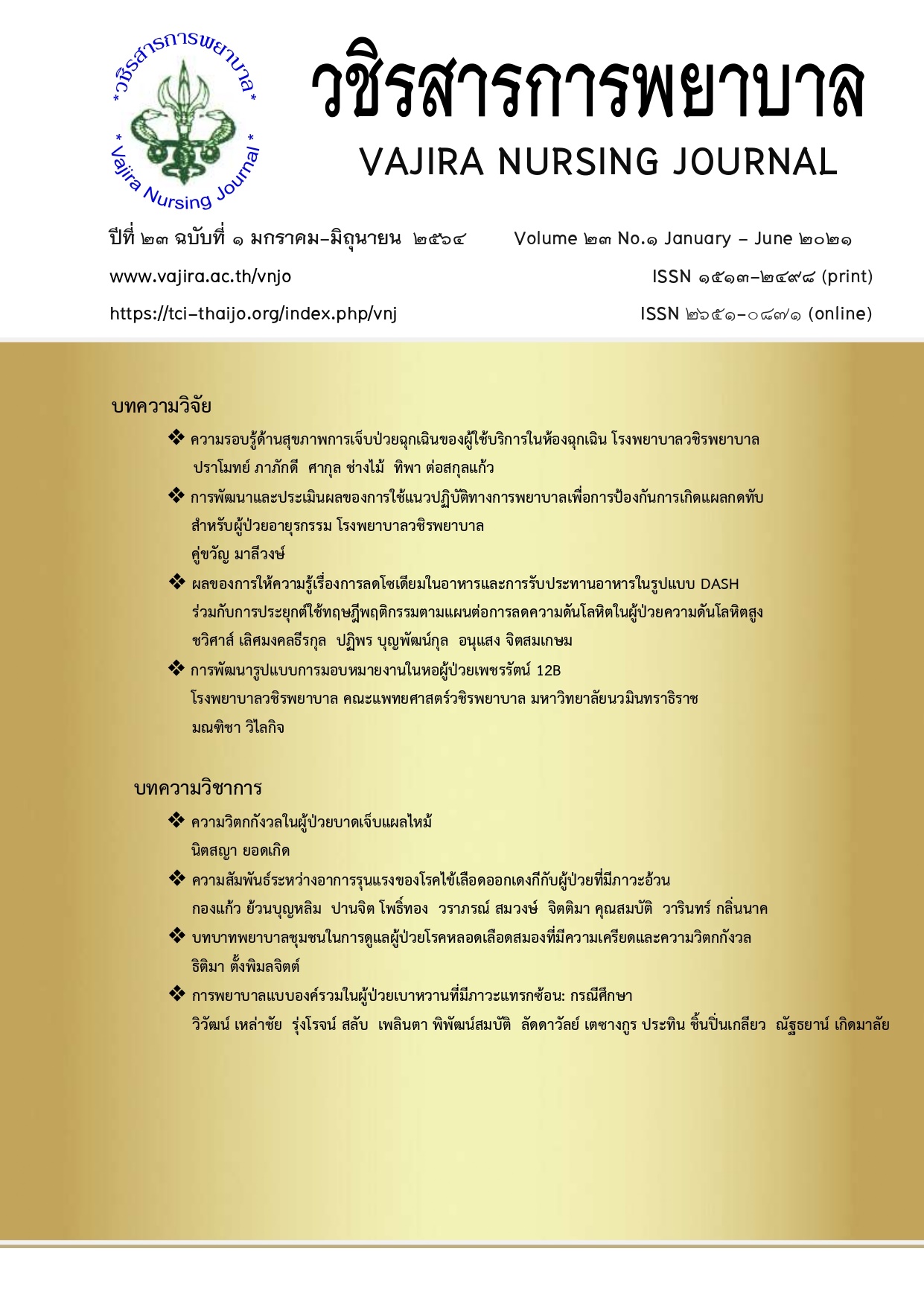ความสัมพันธ์ระหว่างอาการรุนแรงของโรคไข้เลือดออกเดงกีกับผู้ป่วยที่มีภาวะอ้วน
Main Article Content
บทคัดย่อ
โรคไข้เลือดออกเดงกี (dengue hemorrhagic fever; DHF) เกิดจากยุงลาย (aedes aegypti) ที่มีเชื้อไวรัสเดงกี (dengue virus) กัด ผู้ป่วยโรคไข้เลือดออกเดงกีที่มีภาวะอ้วนเมื่อเกิดภาวะช็อกนานจะส่งผลให้เกิดภาวะแทรกซ้อนขึ้นหลายระบบภายในร่างกาย เช่น ภาวะหายใจล้มเหลวเฉียบพลัน (acute respiratory failure) เกิดจากทรวงอกขยายตัวได้ไม่ดี และการมีไขมันในช่องท้องปริมาณมากเมื่อมีน้ำในช่องท้องมากส่งผลให้ความดันในช่องท้องสูงยิ่งขึ้น จนไปกดหลอดเลือดทำให้เลือดไปเลี้ยงอวัยวะในช่องท้องลดลง (abdominal compartment syndrome) และไขมันสะสมที่ตับเสี่ยงต่อการเกิดตับอักเสบเฉียบพลัน (hepatic encephalopathy) นอกจากนี้ผู้ป่วยไข้เลือดออกเดงกีที่มีภาวะอ้วนมีความเสี่ยงต่อการเกิดไตวายเฉียบพลันมากกว่าผู้ป่วยไม่อ้วน เนื่องจากในช่องท้องมีเนื้อเยื่อไขมันมาก ทำให้ความจุภายในช่องท้องลดลง เมื่อมีน้ำในช่องท้องจะเกิดเลือดไปเลี้ยงไตลดลง
ดังนั้นผู้ป่วยไข้เลือดออกเดงกีที่มีภาวะอ้วน ควรได้รับการรักษาพยาบาลอย่างใกล้ชิดเพื่อลดการเกิดภาวะแทรกซ้อน รวมถึงการดูแลผู้ป่วยอย่างถูกต้องและมีประสิทธิภาพจะทำให้อัตราการรอดชีวิตของผู้ป่วยโรคไข้เลือดออกเดงกีที่มีภาวะอ้วนเพิ่มมากขึ้น
Article Details

อนุญาตภายใต้เงื่อนไข Creative Commons Attribution-NonCommercial-NoDerivatives 4.0 International License.
เนื้อหาและข้อมูลในบทความที่ลงตีพิมพ์ในวชิรสารการพยาบาลถือเป็นข้อคิดเห็นและความรับผิดชอบของผู้เขียนบทความโดยตรง ซึ่งกองบรรณาธิการไม่จำเป็นต้องเห็นด้วย หรือร่วมรับผิดชอบใด ๆ ทั้งสิ้น
บทความ ข้อมูล เนื้อหา รูปภาพ ฯลฯ ที่ได้รับการตีพิมพ์ในวชิรสารการพยาบาล ถือเป็นลิขสิทธิ์ของวชิรสารการพยาบาล หากบุคคลใดหรือหน่วยงานใดต้องการนำทั้งหมดหรือส่วนหนึ่งส่วนใดไปเผยแพร่ต่อหรือเพื่อกระทำการใด ๆ จะต้องได้รับอนุญาตเป็นลายลักอักษรจากวชิรสารการพยาบาลก่อนเท่านั้น
เอกสารอ้างอิง
กระทรวงสาธารณสุข, กรมควบคุมโรค, กองโรคติดต่อนำโดยแมลง, กลุ่มโรคติดต่อนำโดยแมลง. (2562). รายงาน พยากรณ์โรคไข้เลือดออกปี 2562. เข้าถึงได้จากhttps://ddc.moph.go.th/uploads/ckeditor/6f4922f45568161acdf4ad2299f6d23/files/Dangue/Prophecy/2562.pdf
กุลพร สุขุมาลตระกูล และคณะ. (2561). หุ่นดี สุภาพดี ง่าย ๆ แค่ใช้ 4 พฤติกรรม (พิมพ์ครั้งที่ 1). กรุงเทพฯ:โครงการผลิตสื่อและมัลติมีเดีย สมาคมส่งเสริมเทคโนโลยี (ไทย-ญี่ปุ่น).
กลมวิช เลาประสพวัฒนา. (2560). การติดเชื้อไวรัสเดงกีจากทฤษฎีสู่ปฏิบัติ (พิมพ์ครั้งที่ 1). กรุงเทพฯ:สหมิตร พัฒนาการพิมพ์.
วิภา ธนาชาติเวทย์, สุพัฒน์ ชำนาญชานันท์ และชญาสินธุ์ แม้นสงวน. (2563). โรคไข้เลือดออกเดงกี. เวชปฏิบัติ: ไข้ในโรคเขตร้อน (พิมพ์ครั้งที่ 1). กรุงเทพฯ: สำนักพิมพ์ บริษัท เนติกุลการพิมพ์ จำกัด. 59-84.
ศิริเพ็ญ กัลยาณรุจ, มุกดา หวังวีรวงศ์ และวารุณี วัชรเสวี. (2561). การวินิจฉัยและการรักษาโรคไข้เลือดออกเดงกีฉบับเฉลิมพระเกียรติ 80 พรรษามหาราชินี (พิมพ์ครั้งที่ 4). กรุงเทพฯ: องค์การสงเคราะห์ทหารผ่านศึก.
Laoprasopwattana K, Chaimongkol W., and Pruekprasert P. (2017). Prothrombin time prolongation was the most important indicator of severe bleeding in children with severe dengue viral infection. Trop Pediatr, 63(1), 314-20.
Peter Gallagher, Kuan Rong Chan, Laura Rivinoc, Sophie Yacoub. (2020). The association of obesity and severe dengue: possible pathophysiological mechanisms. Journal of Infection, 81(1), 10-16.
Sarnaik Ap, Clark JA and Sarnaik AA. (2016). Respiratory distress and failure. Nelson textbook of pediatrics, 20(1), 528-44.
Sorawat Sangkaew and et al. (2021). Risk predictors of progression to severe disease during the febrile phase of dengue: a systematic review and meta-analysis. Lancet Infect Disease. Retrieved from www.thelancet.com/infection.
Victoria Phooi Khei Tan and et al. (2018). The association between obesity and dengue virus (DENV) infection in hospitalized patients. PLOS ONE, 13(7), 1-14.
World Health Organization. (2020). Dengue. Retrieved from https://www.who.int/news-room/fact-sheets/detail/dengue-and-severe-dengue.


